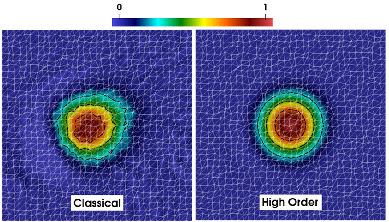当前位置:
X-MOL 学术
›
Int. J. Numer. Methods Fluids
›
论文详情
Our official English website, www.x-mol.net, welcomes your
feedback! (Note: you will need to create a separate account there.)
A framework to perform high-order deconvolution for Finite-Volume Method on simplicial meshes
International Journal for Numerical Methods in Fluids ( IF 1.7 ) Pub Date : 2020-04-28 , DOI: 10.1002/fld.4839 Manuel Bernard 1 , Ghislain Lartigue 2 , Guillaume Balarac 1, 3 , Vincent Moureau 2 , Guillaume Puigt 4
International Journal for Numerical Methods in Fluids ( IF 1.7 ) Pub Date : 2020-04-28 , DOI: 10.1002/fld.4839 Manuel Bernard 1 , Ghislain Lartigue 2 , Guillaume Balarac 1, 3 , Vincent Moureau 2 , Guillaume Puigt 4
Affiliation

|
In this paper, a new framework to design high-order approximations in the context of node-centered FiniteVolumes on simplicial meshes is proposed. The major novelty of this method is that it relies on very simple andcompact differential operators, which is a critical point to achieve good performances in the High-PerformanceComputing (HPC) context. This method is based on deconvolution between nodal and volume-average valueswhich can be conducted to any order. The interest of the new method is illustrated through three differentapplications : mesh-to-mesh interpolation, levelset curvature computation and numerical scheme for convection.Higher-order can also be achieved within the present framework by introducing high-rank tensors. Althoughthese tensors feature many symmetries, their manipulation can quickly become an overwhelming task. For thisreason and without loss of generality, the present papers is limited to third-order expansion. This method,although tightly connected to thek-exact schemestheory, does not rely on successive corrections: the high-orderproperty is obtained in a single operation, which makes them more attractive in terms of performances.
中文翻译:

在简单网格上对有限体积方法执行高阶反卷积的框架
在本文中,提出了一种在单纯网格上以节点为中心的有限体积的上下文中设计高阶近似的新框架。这种方法的主要新颖之处在于它依赖于非常简单和紧凑的微分算子,这是在高性能计算 (HPC) 环境中实现良好性能的关键点。该方法基于节点和体积平均值之间的去卷积,可以进行任何阶数。新方法的意义通过三个不同的应用来说明:网格到网格插值、水平集曲率计算和对流数值方案。通过引入高阶张量也可以在当前框架内实现高阶。尽管这些张量具有许多对称性,但它们的操作很快就会成为一项艰巨的任务。为此,不失一般性,本文仅限于三阶展开。这种方法虽然与 k 精确方案理论紧密相连,但不依赖于连续修正:在单个操作中获得高阶性质,这使得它们在性能方面更具吸引力。
更新日期:2020-04-28
中文翻译:

在简单网格上对有限体积方法执行高阶反卷积的框架
在本文中,提出了一种在单纯网格上以节点为中心的有限体积的上下文中设计高阶近似的新框架。这种方法的主要新颖之处在于它依赖于非常简单和紧凑的微分算子,这是在高性能计算 (HPC) 环境中实现良好性能的关键点。该方法基于节点和体积平均值之间的去卷积,可以进行任何阶数。新方法的意义通过三个不同的应用来说明:网格到网格插值、水平集曲率计算和对流数值方案。通过引入高阶张量也可以在当前框架内实现高阶。尽管这些张量具有许多对称性,但它们的操作很快就会成为一项艰巨的任务。为此,不失一般性,本文仅限于三阶展开。这种方法虽然与 k 精确方案理论紧密相连,但不依赖于连续修正:在单个操作中获得高阶性质,这使得它们在性能方面更具吸引力。











































 京公网安备 11010802027423号
京公网安备 11010802027423号